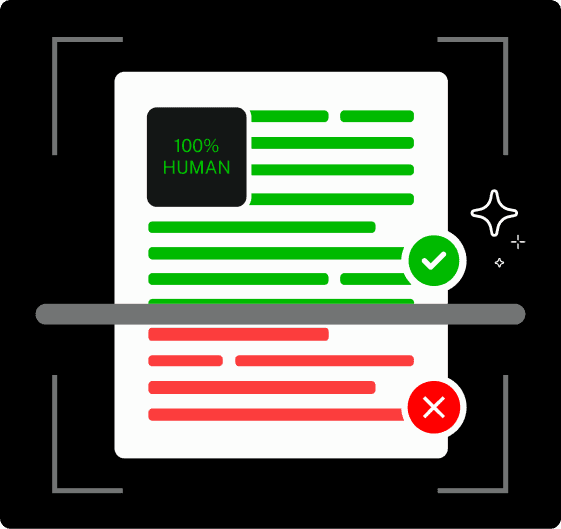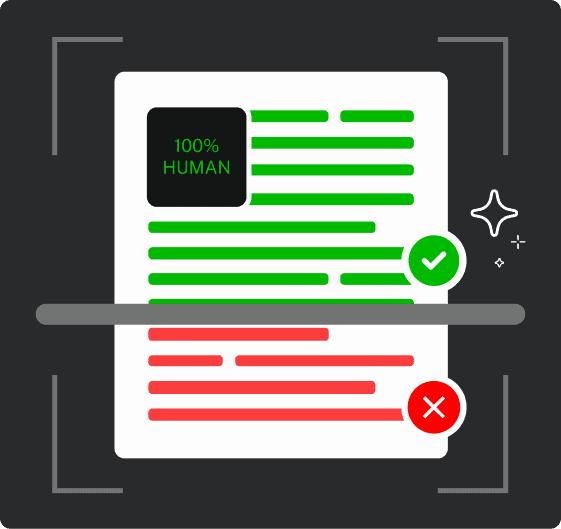Your student has poured hours into an assignment. They’ve done all the research and wrote every word themselves.
Polished it until it was just right. But when they submit it, you’re blindsided by a ding that their work has been falsely accused of AI plagiarism. How could this happen?
Plagiarism is a growing problem in schools, we all know that. But it’s especially become more widespread as classes move online and adopt a hybrid model.
n fact, plagiarism rates spiked by more than 20% as classes moved online and adopted a hybrid model. To keep up, schools are relying more on plagiarism-detection tools.
But these tools, while useful, aren’t perfect. They’re there to help, but the final call still rests with the teacher.
If you’re an educator (or really any professional who needs to check the content you send), using a plagiarism checker has likely become part of your routine.
These tools are essential nowadays for spotting potential issues quickly.
So, how do plagiarism checkers work? Understand the ins and outs of plagiarism checkers so you can ensure fairness for every student.
Key Takeaways
- Plagiarism checkers use keyword, phrase, and content-matching analyses to detect copied or AI-generated text.
- Accuracy depends on database size and detection methods—free tools often miss subtle matches.
- Undetectable AI stands out by combining plagiarism detection with AI humanization for authentic writing.
- It checks content across eight AI detectors and customizes tone and style to ensure originality and natural flow.
How Does Plagiarism Checker Work?

Plagiarism happens more easily than you might think. Sometimes, it’s intentional, like copying someone else’s work and passing it off as your own.
But other times, it’s accidental, maybe because of a misunderstood citation or simply forgetting to give proper credit.
There are different types of plagiarism. It’s almost hard to keep track.


Never Worry About AI Detecting Your Texts Again. Undetectable AI Can Help You:
- Make your AI assisted writing appear human-like.
- Bypass all major AI detection tools with just one click.
- Use AI safely and confidently in school and work.
And while a keen eye can catch some of these issues, doing the work manually is time-consuming and isn’t practical in the long run.
This is where a reliable plagiarism checker comes in handy. It saves you time and energy by scanning for potential issues that might slip through the cracks.
Knowing how to check for plagiarism means figuring out the best checkers to use. Some are more accurate than others, and each has its own set of unique features.
That’s why it’s crucial to pick one that’s proven to be accurate and fits your specific needs.
Even though plagiarism tools vary, they generally rely on common analysis methods to detect plagiarism.
Let’s go into the features so you can know what to expect when using a plagiarism checker.
Keyword Analysis
Keyword analysis is one of the most common methods used by plagiarism checkers.
It basically scans the text for specific words or phrases and compares them to other texts available online.
Keywords refer to any significant word or phrase that appears frequently or is central to the content.
Plagiarism checkers use advanced database software to perform this analysis. Behind the scenes, these tools are constantly crawling and indexing web content.
When you run someone’s text through a plagiarism checker, it scans for exact keyword matches.
Once it finds a match, the tool highlights parts that might be plagiarized for review.
Some advanced plagiarism checkers can even detect paraphrased versions of this phrase.
This highlights the areas where the wording is too similar to the original source.
Keyword analysis is effective because it targets the most critical elements of any text.
With a strong focus on keywords, the checker can quickly identify areas that might need further review or citation.
Phrase Analysis
Phrase analysis takes the process a step further than just keywords by looking at the order of words within specific phrases.
In this method, the plagiarism checker examines word sequences to determine if they match phrases from other texts.
A phrase here refers to any group of words that appear together in a specific order.
This type of analysis is particularly useful for identifying more subtle forms of plagiarism, like when someone slightly rewords a sentence but keeps the original structure intact.
Phrase analysis also uses a data science technique called “string matching,” which compares the sequence of words in the text to those in its database.
The tool has an algorithm that flags plagiarism if it has a minimum number of words in the same order.
For example, if you write the phrase “the rapid growth of technology in recent years,” and this exact sequence of words appears in another source, the plagiarism checker will flag it if it exceeds the threshold.
This method is very useful in identifying cases where someone tries to hide their plagiarized content by making minor changes to the text.
Content Matching Analysis
Compared to keyword and phrase matching, content matching analyzes the structure and style of the text.
Rather than just looking for exact matches or similar phrases, this type of analysis examines how someone’s content is organized and how it “sounds” in comparison to other texts.
Content matching looks at sentence structure, tone, and even the order of the words.
If the content closely matches another published article, the plagiarism checker can flag it as a potential match.
Note that this method can be particularly sensitive, sometimes leading to false positives, where correctly cited content is flagged by mistake.
But it can also provide valuable insights into which parts of the text might need to be revised to ensure originality.
In the end, checkers are still just tools to check and for you to verify.
Another factor is that not all plagiarism checkers can access the same database.
Free plagiarism checkers usually have smaller databases and may miss some matches, especially in niche content.
High-quality plagiarism checkers, on the other hand, have access to larger databases, making them more reliable at detecting content matches.
Fragments Matching Analysis
Also known as fingerprint analysis, fragments matching searches for small portions or “fragments” of the text that might match other content.
This can be quite powerful because it can detect even the slightest similarities, such as when a text has been paraphrased or restructured.
Fragments refer to small sections of the text, such as a sentence or a phrase.
And then each fragment is assigned a unique “digital fingerprint,” which the tool uses to check for matches.
The plagiarism checker uses fingerprinting to identify these fragments and compare them to others in its database.
As you can see, each method offers unique insights into the originality of any content.
By understanding how something like a ChatGPT plagiarism checker works, you can make informed decisions about which checker to use and how to interpret the results they give.
How to Check for Plagiarism on Different Types of Content

Now, checking for plagiarism isn’t a one-size-fits-all process. Different types of content require different approaches.
Whether you’re working with thesis papers, blog posts, creative writing, or other technical documents, each type of content is made in such a way that they differ from each other in how plagiarism should be detected.
Here are the effective ways to check for plagiarism, no matter the content you’re checking.
Plagiarism Checker for Papers
When you’re dealing with an academic paper, originality is a non-negotiable. Academic integrity is the cornerstone of scholarly work.
It’s important to make sure any paper is free from plagiarism. Here’s how you can do that:
- Choose the Right Plagiarism Checker: Use a tool designed for academic content. You can even do this in Google Docs. These tools have large databases that include academic journals, books, and other scholarly sources, making them much more reliable than the basic ones.
- Double-Check Citations: Before running a plagiarism check, you can easily check if the citations and references are properly formatted. This helps you avoid false positives.
- Check in Stages: If you’re the student or writer, be sure to run the paper through the plagiarism checker at different stages – once after your first draft and then again after the revisions. This lets you catch any issues early and gives you time to make corrections.
This step-by-step approach makes sure you don’t detect someone’s work unfairly, which can be discouraging for your students.
Plagiarism Checking in Professional Writing
As you might already know, plagiarism cases go around – even in the workplace.
In professional writing, plagiarism has some really serious consequences that can damage your reputation and diminish the value of your work.
That’s why it’s essential to use a plagiarism checker that specializes in professional content.
These tools are specifically designed to scan web content, blog posts, and articles, comparing the text against billions of other sources found online.
After running your content through the checker, review the flagged sections carefully.
Sometimes, what appears to be a match may simply be a common phrase or a widely accepted industry term.
But if you notice that the flagged content is too similar to another source, consider rephrasing or adding proper citations. It’s a great defense mechanism to protect your content before it gets out there.
Undetectable AI’s Plagiarism Checker
With so many AI tools out there, picking the right one can feel overwhelming.
That’s where Undetectable AI comes in, rated the #1 Best AI Detector by Forbes.
This tool is a standout choice for detecting plagiarism – especially when dealing with AI-generated content.
Undetectable AI works by pulling results from eight different AI checkers, so it can easily and accurately spot AI-written text and pass and pass whatever detector it’s going through.
But what really sets Undetectable AI apart is its customizability. It has an AI humanizer feature that lets you adjust the tone and style of your writing to make it sound natural and engaging.
This is perfect for anyone who wants their work to maintain a human touch.
Undetectable AI goes beyond plagiarism detection, making sure that all content stays original and true to a writer’s voice.
It’s a truly reliable, all-in-one tool that makes handling AI-generated text a breeze.
See what our AI Detector and Humanizer can do—try them below!
Conclusion
Knowing how to check for plagiarism makes all the difference.
The right tools do more than just scan for copied text – they should be able to dig deep into the content, checking keywords, phrases, and even the structure to make sure everything is original.
Using a plagiarism checker helps you avoid unintentional mistakes and boosts the credibility of your work.
For students, it means academic integrity. And for professionals, it means keeping their reputations.
But remember that while these tools are powerful, they’re most effective when combined with your own careful review.
So the next time you’re preparing to check or publish some work, make Undetectable AI a part of your routine.
It’s the reliable ally you need to keep any content authentic. It’s time for you to take advantage of AI and focus on the big tasks that make your work worthwhile.
